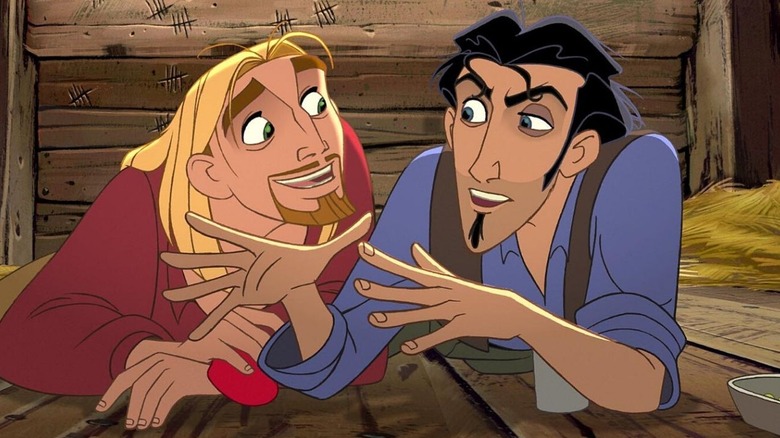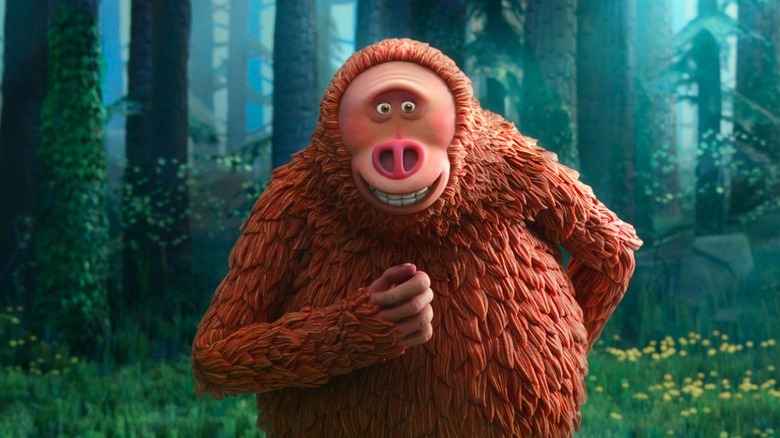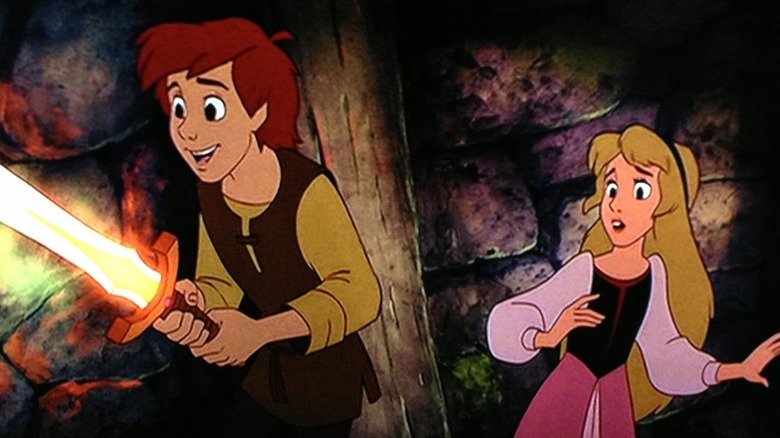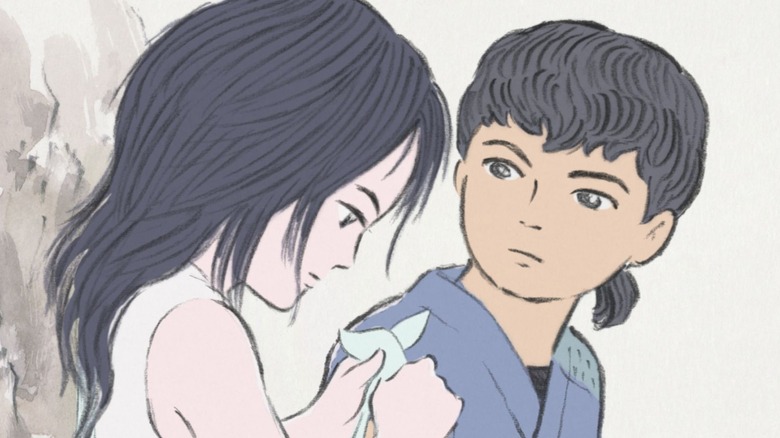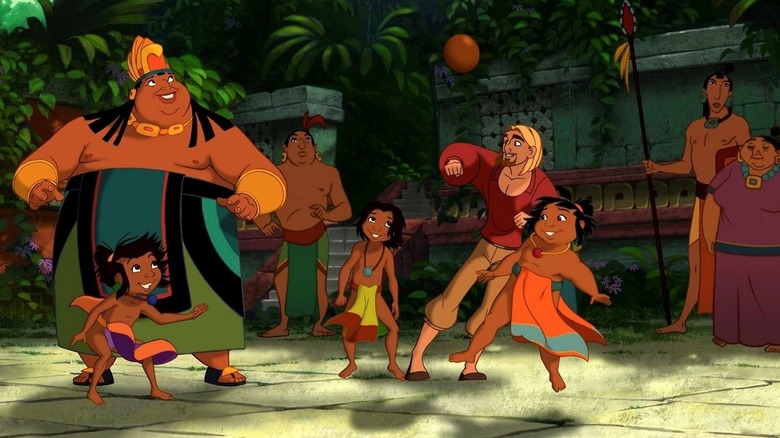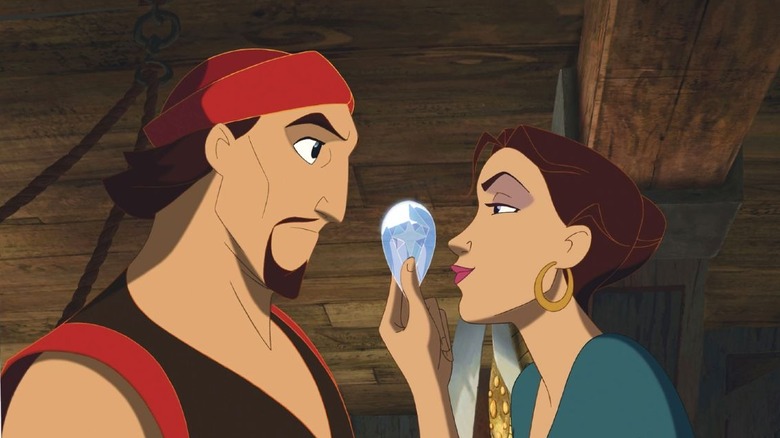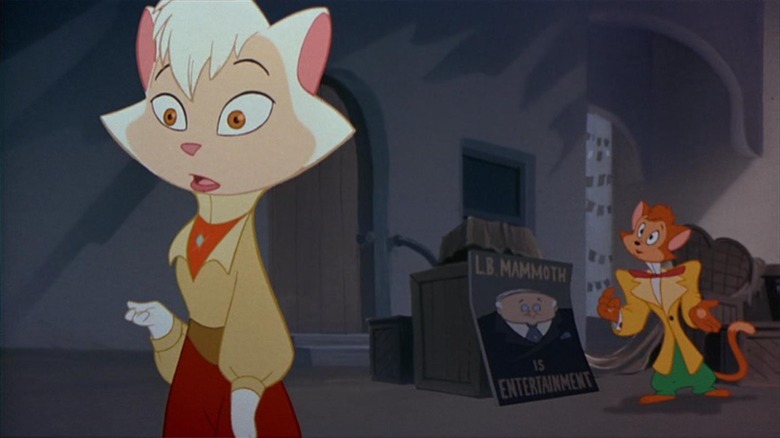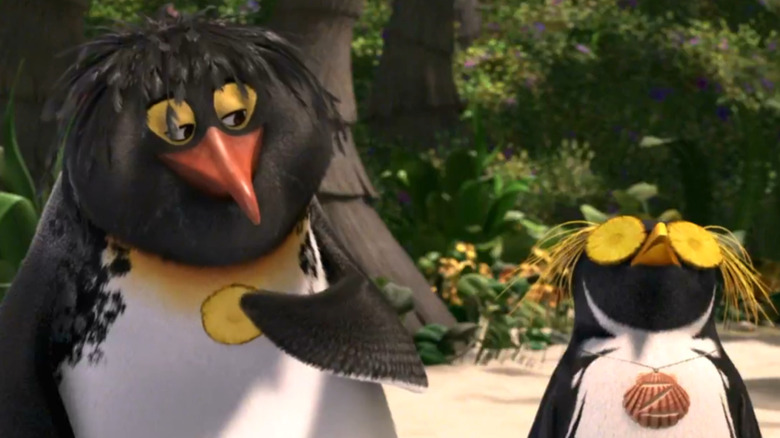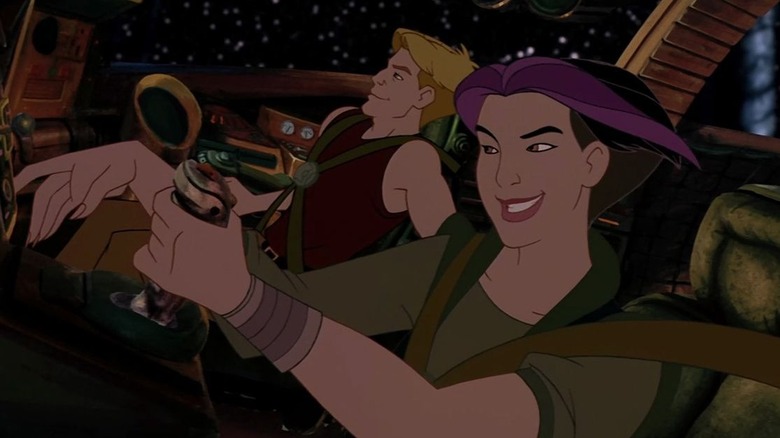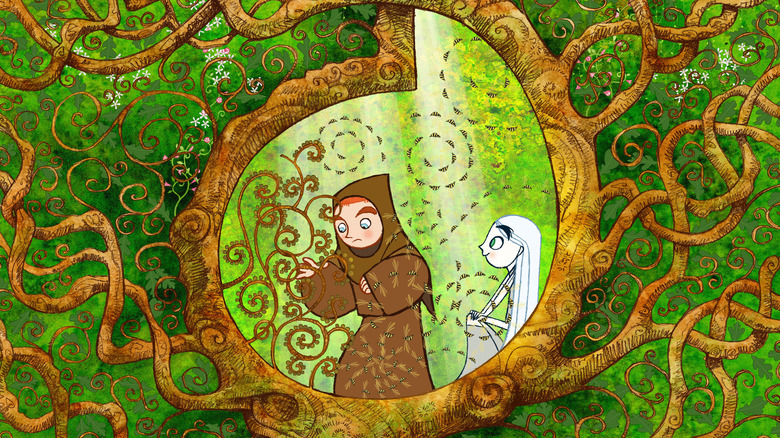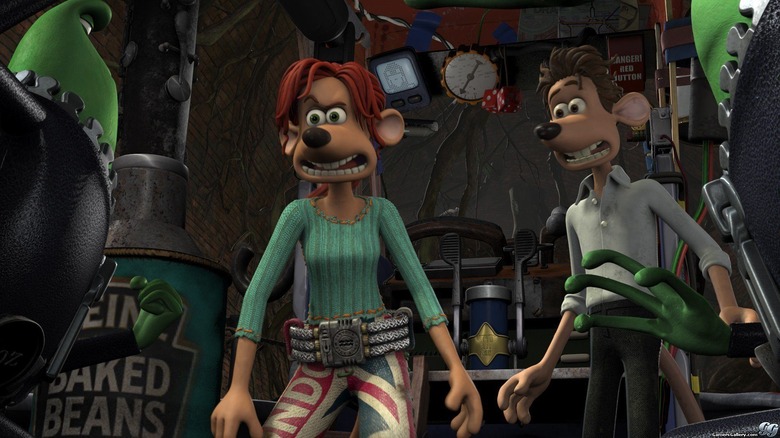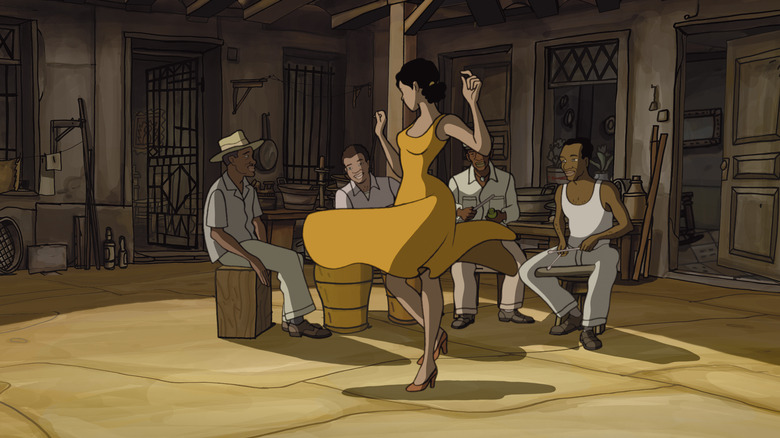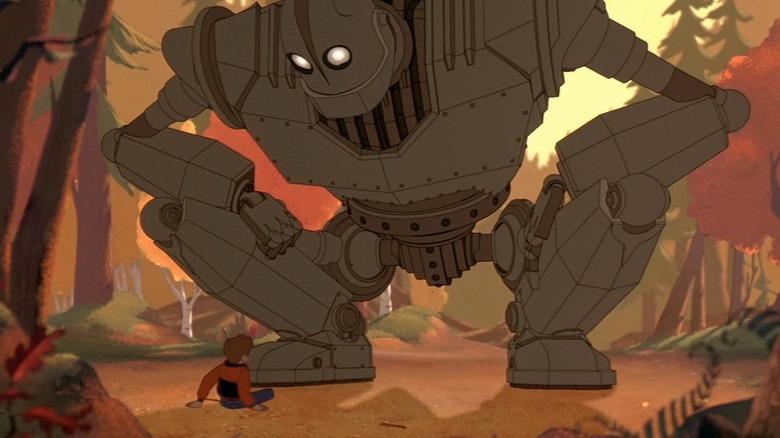Animated Box Office Bombs That Deserve A Second Chance
Whether you were first enthralled by them in the theater or on VHS, DVD, Blu-ray, or streaming services, animated films are a cornerstone of film-based nostalgia. To be labeled a box office bomb is not pleasant, but how many dollars an animated film rakes in at the box office does not directly correlate with its quality or the reputation that it earns after its theatrical debut.
Some films may have been greeted with mixed reviews, only to find their audiences years later. Some may have been critically acclaimed, but did not resonate with general audiences. Poor marketing, personnel changes inside studios, and internal games of tug-of-war over how much an animated movie should appeal to kids — or adults — can doom an animated feature's box office prospects. Still, all of these films have enough merit, charm, and artistry to make viewers wonder, "Now, why didn't this go right?" Quite simply, these animated box office bombs deserved better.
The Missing Link
Following the receipt of a mysterious letter, Sir Lionel Frost, a self-centered explorer, ventures into the wild to find the furry humanoid creature known as the Missing Link, aka Bigfoot. To his astonishment, he discovers that the letter came from the creature himself. So, Frost agrees to help Mr. Link — yes, that's his name — find his own kind in the frosty Himalayas. Joined by Link's old flame, Lionel and his furry friend embark on their journey, unaware that they're being hunted by Lionel's chief rival, who views the discovery of the monster as a threat to the status quo.
Like "Coraline," "Kubo and the Two Strings," and "Boxtrolls," "The Missing Link" features Laika's dazzling stop-motion handiwork, and is full of inventive action sequences, including a chase on a rickety boat and a safe-cracking heist.
Unfortunately, "The Missing Link" only grossed $26 million against its $102 million budget during its 2019 release. Its poor theatrical run sparked some speculation that its more mainstream approach, compared to Laika's edgier and more innovative films, was its downfall. But even if it is one of Laika's weaker stories, its shortcomings do not negate visual feast that "The Missing Link" provides. Besides, "The Missing Link" did result in a surprising upset when it won the best animated feature at the Golden Globes, beating out "Toy Story 4."
The Black Cauldron
When watching 1985's "The Black Cauldron," you don't have to know anything about its troubled production to notice that it's stacked with tonally disparate elements. Disney wanted to subvert its identity as a maker of lighthearted animation, and "The Black Cauldron" is the end result of that mission. However, the final film mixes kid-oriented adventure with a ghastly, macabre atmosphere, making it a little difficult to tell if it's for children or adults.
Set in a medieval fantasy kingdom, a young pig keeper aspires to knighthood, lamenting his lowly position. Then, he's tasked with taking a pig with a magical snout to safety. However, the Horned King captures the boy and the pig. The pig keeper learns that he must prevent the king from accessing a magical cauldron. Along the way, he befriends a princess, a cowardly furry creature, and a snarky old bard. How much is he willing to sacrifice to save the world?
The Horned King, voiced by John Hurt, and his mission to raise the dead make him a truly terrifying villain, especially for young viewers. You can see Disney's attempts to create something new wherever you look, including the multi-tinted procession of zombies and Disney Animation's first application of computer-generated imagery. For all of its faults, animation fans should appreciate "The Black Cauldron" for its artistic endeavors. Unfortunately, its $21 million box office earnings (against a budget of $44 million) ensured that "The Black Cauldron" did not get a home video release until 13 years after its debut.
The Tale of Princess Kaguya
Released in 2013, "The Tale of Princess Kaguya" is the final feature by Isao Takahata, who founded Studio Ghibli alongside Hayao Miyazaki, and who died in 2018. Based on an ancient Japanese folktale, "The Tale of Princess Kaguya" is about a bamboo cutter who discovers a girl inside a bamboo stalk and adopts her. Growing at an exponential rate, the girl, Kaguya, spends her childhood enjoying the pastoral life of her home. But when her father discovers gold and silk kimonos in the bamboo in which she originated, he uproots Kaguya and plops her into a palace, where he assumes she'll be happy. What follows is a downward spiral into a patriarchal nightmare, in which Kaguya is viewed as a prize to be won by lecherous and deceptive nobles. She grits her teeth and gives in to protocol because of filial piety. Tragedy ensues.
For all its luscious beauty, "Kaguya" did not perform well in either Japan or the United States. While it received critical acclaim, "The Tale of Princess Kaguya" has the most experimental visuals of any Studio Ghibli film. Its delicate watercolor-style art, and one memorable sequence in which a sorrowful Kaguya rips through the palace doors, shreds the weight of hundreds of kimonos, and tears through the forest, are absolutely stunning, but may have been a hard sell for audiences looking for a more traditional anime.
The Road to El Dorado
Released in 2000, "The Road to El Dorado" could have struck a very different mood had DreamWorks Animation taken the more serious route that was originally planned for it. In the movie, con artists Miguel and Tulio acquire a map to the titular golden city and then get trapped on the ship of conquistador Hernán Cortés. Soon, they chance upon the isle that leads them to El Dorado. The high priest pegs them as savior gods and worships them as royalty — but how long can Miguel and Tulio keep up the deception?
With eye-popping color and vibrant adventures, "The Road to El Dorado" is stuffed with swashbuckling action and priceless banter courtesy of the chemistry between Kenneth Branagh and Kevin Kline. The camaraderie between Miguel, Tulio, and their ally Chel is really the heart of the film.
Yes, the songs by Elton John feel phoned in, and the treatment of indigenous people is troublesome, particularly the film's reliance on white savior tropes and its sexualization of an indigenous woman. Still, many feel that its good parts outweigh its faults. Too bad that it only made $76 million in theaters, which was below its $95 million budget.
Sinbad: Legend of the Seven Seas
It's a shame that 2003's "Sinbad: Legend of the Seven Seas" was the final DreamWorks feature made with traditional 2D animation, because it unleashed its own flood of folkloric invention. The infamous pirate Sinbad and his crew are out to steal the magical Book of Peace, but Eris, the goddess of discord, ends up stealing the book herself and framing Sinbad. Sinbad's princely friend Proteus offers to be executed in his place in seven days if Sinbad doesn't return the book. Joined by an ambassador with wanderlust, Sinbad begins hunting for the treasure, realizing that deep inside he wants to be honorable after all.
With a delicious performance by Michelle Pfeiffer, Eris headlines some of the film's most inventive animated sequences, watching the Earth through the images in her cocktails or bath bubbles and inflicting chaos on the human world. Through torrential streams of sirens, an island that turns out to be the backside of a beast, and the waterfalled Edge of the World, "Sinbad: Legend of the Seven Seas" sails from adventurous set piece to set piece, stunning viewers along the way (the Greco-Roman approach to whitewashing the story's Arabic inspiration, however, hasn't aged as well).
"Sinbad" competed with Pixar's "Finding Nemo" and "Pirates of the Caribbean: Curse of the Black Pearl" at the box office, and while it earned $80 million against a $60 million budget, it could not make up for previous DreamWorks losses. Producer Jeffrey Katzenberg declared it the nail in the coffin for traditional animation at the company.
Cats Don't Dance
A tribute to the golden age of musicals, Turner Animation's family-friendly 1997 feature "Cats Don't Dance" is a not-so-subtle allegory about fighting marginalization in show biz. Look, when a hand-drawn animated film enlists legendary "Singing in the Rain" star Gene Kelly as a dance consultant, you know you are in for a unique musical experience.
Slyly standing out from the Disney repertoire, "Cats Don't Dance" turns the animal sidekick trope on its head. These anthropomorphic animals are looking for jobs in Hollywood, and see minor roles as meager blessings, not even considering the possibility of landing a leading part. But Danny, an orange tabby, dreams big — he'll do whatever it takes to get his animal castmates their big break. However, the young Shirley Temple-esque Darla Dimples, a spotlight hog who's not fond of animals, seeks to sabotage their attempts.
"Cats Don't Dance" only made back $4 million of its $32 million budget. When Warner Bros. Animation acquired Turner in 1996, it barely bothered marketing the film. As director David Kirschner explains, Warner wasn't interested because "It wasn't Bugs Bunny or Daffy Duck or the great Warner characters." Armed with a toe-tapping score by Randy Newman, kinetic slapstick, and humorous contrasts between the large and small (the King Kong-sized butler who does the tiny Darla's evil bidding is a highlight), "Cats Don't Dance" is a treasure trove of gags that deserves to be seen.
Surf's Up
Come for the mockumentary shenanigans, stay for the sincere lessons about living free on the tides. Directed by Ash Brannon and Chris Buck, 2007's "Surf's Up" may seem like it's cashing in on "March of the Penguins," "Madagascar," and "Happy Feet," but this one frames its cutesy premise in a shrewd mockumentary format, with a quirky cast that messes up interviews, has mishaps on live mics, and can't stop crowds of bystanders from entering the shots.
The in-film "documentary" focuses on the coming-of-age of Cody Maverick, a northern rockhopper penguin who was born for the waves. He ventures to a tropical island to compete in a surfing contest to honor his hero, the Big Z, but learns there is more to surfing than the first-place trophy — and that the seemingly deceased Big Z is alive and well. Can Cody rekindle Big Z's love of surfing?
Made by Sony Pictures Animation, "Surf's Up" charmed enough critics to earn a nomination for best animated feature at the Academy Awards (it lost to "Ratatouille"), but its $145 million earnings against its $100 million budget made it an underperformer.
Titan A.E.
Fox wanted its own "Star Wars"-inspired animated franchise. It got it in "Titan A.E.," its final film. Even with the aged CGI visuals that interact with traditional hand-drawn animation, "Titan A.E." explodes with a supernova of imagination. As Earth is destroyed by the energy-based creatures, a father entrusts a special ring to his young son, Cale. Humanity scatters throughout the galaxy. 15 years later, Cole is a cynical window washer too drained of hope to help humanity. That changes when he's enlisted to help find a human-made planet that could become a new home for his people.
Directed by former Disney animators Don Bluth and Gary Goldman, "Titan A.E." is a film that deserved more. Even though it trades on well-known space opera tropes — there's an apocalypse, aliens who don't take kindly to humans, and a boy who literally holds the future of humanity in his hands — "Titan A.E." is full of Bluth's quirky touches, transporting the viewer through imaginative setpieces. This is decidedly Bluth's most adult animated feature, with bleeding, cursing, and brief nudity. Maybe that's why it failed to connect with audiences, who still regarded animation as pure kiddie fare; of course, a marketing budget hindered by cutbacks at Fox Animation Studios probably didn't help, either.
The Secret of Kells
Springing from a fruitful garden of Celtic imagination, "The Secret of Kells" is the first feature film from the Ireland-based Cartoon Saloon. It concerns a young monk named Brendan who lives in ancient monastic Ireland. Brendan needs to venture beyond his village's walls to harvest the berries used to make ink, which will illustrate the medieval manuscripts that will become the Book of Kells. However, the abbot, Brendan's uncle, insists that the boy should forget art and prioritize his safety from the Vikings.
Directed by Tomm Moore, this 2009 movie was a feat for the tiny Kilkenny-based studio, which only had 85 animators. And yet, "The Secret of Kells" snagged a surprise Academy Award nod and competed against the Pixar crowd-pleaser "Up." Even though "The Secret of Kells" lost the Oscar, its embroidery-inspired design remains a testament to the handicraft of Irish animators and their affection for folklore.
Succeeding Cartoon Saloon animated features — "Song of the Sea," "The Breadwinner," and "Wolfwalkers" — also raked in critical acclaim, but never made back their budget at the box office. However, Cartoon Saloon has found both life and sustainability through various streaming services.
Flushed Away
The 2006 film "Flushed Away" was the final collaboration between Aardman Animations and DreamWorks Animation, following "Chicken Run" and "Wallace & Gromit: The Curse of the Were-Rabbit." Although this CGI film doesn't have Aardman's signature look (the amount of water in the movie made stop-motion animation impossible), "Flushed Away" has all of Aardman's signature humor and physicality.
An upper-crust rat named Roddy is flushed down a toilet, landing in a mouse-populated society in the sewer where he meets Rita, a scavenger rat. Rita and Roddy cut a deal and brave the waters so that she can ferry Roddy back home, although over time he realizes that he may want to stay in her world. During a journey brimming with referential humor and wit, the two are swept up into an evil toad's scheme to flood the sewers, decimate the rodent residents, and populate the world with tadpoles.
While it made back its budget at the box office with a $178 million take, it was ruled an underperformer. "Flushed Away" was nominated for best animated feature at the Critics' Choice Award and won five Annie Awards, including one for writing in a feature production.
Chico and Rita
An adult Spanish film, 2010's "Chico and Rita" is not a high-profile example on this list, making back only $2 million of its $13 million budget. A whirlwind romance set in the jazzy worlds of Cuba and New York in the late '40s, "Chico and Rita" is the story of a Cuban jazz musician named Chico who falls for the vivacious Rita, a dreamy singer. However, numerous heartbreaks, jealous tirades, and conflicting ambitions sever their connection. Rita departs Cuba for NYC and becomes a star, although she faces discrimination in Hollywood, while Chico fades into obscurity. The two lovebirds find pockets of time to love each other from the shadows, although baggage, meddling by acquaintances, and the waves of history intervene in their romance.
"Chico and Rita" is directors Javier Mariscal and Tono Errando's love letter to Cuba and the bolero, a genre of music characterized by love and heartache. While you can imagine a drama like "Chico and Rita" being filmed in live-action, it sings in animation. Its prismatic cities enthrall the eye with rich architecture and vibrant colors, and earned it the honor of becoming the first full-length Spanish animation to be nominated for best animated feature at the Academy Awards.
The Iron Giant
This animated adaptation of the book by poet Ted Hughes may be a little too heavy for young children. Directed by Brad Bird, a "Simpsons" veteran who went on to helm "The Incredibles" and "Ratatouille," "The Iron Giant" became well known for tugging on viewers' heartstrings through its quiet moments, as well as for turning a frank lens on human mortality and the fears that lead to nuclear war.
It is the late '50s, at the height of the Cold War. Paranoia casts its veil on a small town in New England. Nine-year-old Hogarth Hughes discovers a 50-foot extraterrestrial robot. Despite the latter's titanic size and mysterious mission, the two forge a friendship while trying to avoid the attention of an overzealous government agent. While spending time with the boy and learning about Earth's beauty, the Iron Giant fights against his original programming, not sure whether he's a living weapon or a peaceful entity.
"The Iron Giant" was an ambitious undertaking (it was originally conceived as a musical featuring songs by The Who's Pete Townshend), and is notably darker than other kids' movies from the same era. Unfortunately, poor marketing by Warner Bros and the company's lack of faith in the animation market following the failure of "Quest for Camelot" contributed to a flimsy launch and poor box office results. Luckily, "The Iron Giant" was loved by those who actually saw it, and eventually acquired a cult following.
